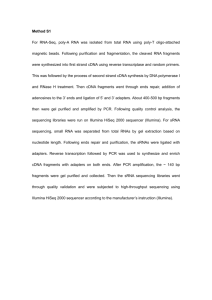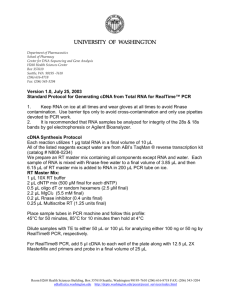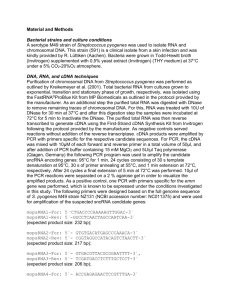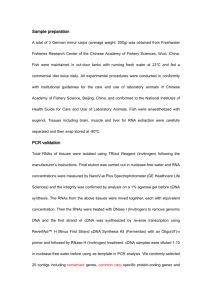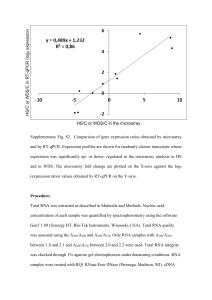MEC_5205_sm_FileS1
advertisement
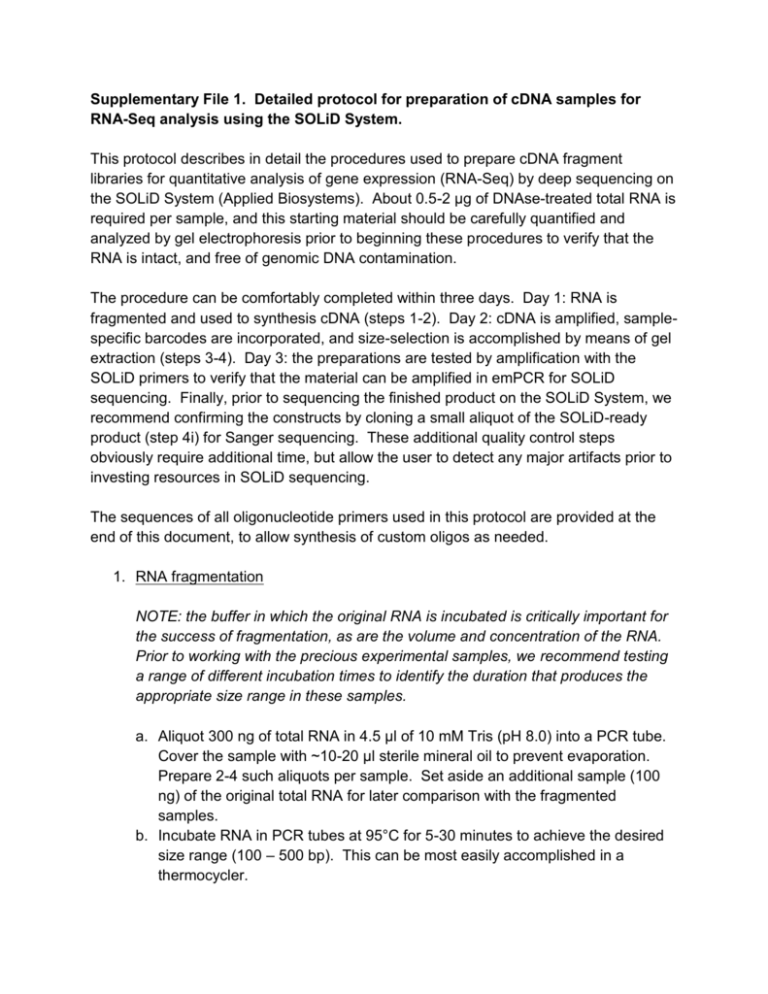
Supplementary File 1. Detailed protocol for preparation of cDNA samples for RNA-Seq analysis using the SOLiD System. This protocol describes in detail the procedures used to prepare cDNA fragment libraries for quantitative analysis of gene expression (RNA-Seq) by deep sequencing on the SOLiD System (Applied Biosystems). About 0.5-2 µg of DNAse-treated total RNA is required per sample, and this starting material should be carefully quantified and analyzed by gel electrophoresis prior to beginning these procedures to verify that the RNA is intact, and free of genomic DNA contamination. The procedure can be comfortably completed within three days. Day 1: RNA is fragmented and used to synthesis cDNA (steps 1-2). Day 2: cDNA is amplified, samplespecific barcodes are incorporated, and size-selection is accomplished by means of gel extraction (steps 3-4). Day 3: the preparations are tested by amplification with the SOLiD primers to verify that the material can be amplified in emPCR for SOLiD sequencing. Finally, prior to sequencing the finished product on the SOLiD System, we recommend confirming the constructs by cloning a small aliquot of the SOLiD-ready product (step 4i) for Sanger sequencing. These additional quality control steps obviously require additional time, but allow the user to detect any major artifacts prior to investing resources in SOLiD sequencing. The sequences of all oligonucleotide primers used in this protocol are provided at the end of this document, to allow synthesis of custom oligos as needed. 1. RNA fragmentation NOTE: the buffer in which the original RNA is incubated is critically important for the success of fragmentation, as are the volume and concentration of the RNA. Prior to working with the precious experimental samples, we recommend testing a range of different incubation times to identify the duration that produces the appropriate size range in these samples. a. Aliquot 300 ng of total RNA in 4.5 µl of 10 mM Tris (pH 8.0) into a PCR tube. Cover the sample with ~10-20 µl sterile mineral oil to prevent evaporation. Prepare 2-4 such aliquots per sample. Set aside an additional sample (100 ng) of the original total RNA for later comparison with the fragmented samples. b. Incubate RNA in PCR tubes at 95°C for 5-30 minutes to achieve the desired size range (100 – 500 bp). This can be most easily accomplished in a thermocycler. c. Analyze 100 ng from each sample of fragmented RNA, alongside the original RNA from that sample, on an agarose gel to evaluate the molecular weight of the fragmented RNA. d. Pool the (n=2-4) aliquots of fragmented RNA produced from each sample, and precipitate with ethanol. To maximize yields, we recommend using 0.1 volume 3 M sodium acetate and 3 volumes 100 % ethanol. Incubate at -20°C for ≥ 20 minutes, then centrifuge at maximum speed for ≥20 minutes in a refrigerated centrifuge (4°C). Rinse the pellet with 100 µl ice-cold 80% ethanol, and air-dry for 15 minutes at room temperature. Dissolve the pellet in 1 µl 10 mM Tris per original aliquot of fragmented RNA (i.e., 2 µl total if two aliquots of 300 ng each were used). 2. First-strand cDNA synthesis NOTE: if RNA quantity is not limiting, first-strand cDNA should be synthesized using 1 µg of fragmented RNA. The reaction shown below is intended for ~500 ng RNA; if 1 µg is available simply double all volumes shown. a. Combine 2 µl fragmented RNA (~500 ng) from (1d) with 0.5 µl of 10 µM primer 3SLD-10TV in a PCR tube. b. Incubate at 65°C for 3 minutes in a thermocycler, then transfer onto ice. c. Prepare a cDNA synthesis master mix. The following volumes are intended for a single reaction, so multiply these values by the number of reactions plus a small additional amount to account for pipetting error: 0.25 µl H2O 0.25 µl dNTP (10 mM each) 0.5 µl DTT 0.1 M 1 µl 5X first-strand buffer (provided with RT) 0.25 µl 10 µM S-SLD-SW (RNA-oligo; must be stored at -80°C) 0.25 µl SuperScript II Reverse Transcriptase (Invitrogen #18064022). d. Add 2.5 µl of this master mix to the RNA from (2b), mix thoroughly, and incubate for one hour at 42°C. e. Incubate at 65°C for 5 minutes to inactivate the RT, dilute 1:5 in H 2O, and store on ice or at -20°C until ready to proceed to the next step. 3. cDNA amplification NOTE: it is important not to over-amplify the cDNA at this stage, to avoid artifacts and distortion of expression ratios. If a visible smear is not produced within 17- 20 cycles, try repeating the PCR with additional template (diluted FS-cDNA from step 2e), up to a maximum of 3 µl, and correspondingly less water in the master mix. If no smear is detected with 3 µl template and 20 cycles, this indicates a problem with the first-strand cDNA synthesis. a. Prepare a PCR master mix. The following volumes are for a single reaction, so multiply these values by the total number of reactions plus a small additional amount to account for pipetting error: 22.5 µl H2O 0.75 µl dNTP (10 mM each) 3 µl 10X PCR buffer (comes with Titanium polymerase) 0.6 µl Titanium polymerase (Clontech #639208) b. Prepare four tubes for each FS-cDNa sample. Aliquot 26.8 µl of the PCR master mix into each tube, then add the following primers: Tube Addition A 1.2 µl H2O B 0.6 µl 10 µM 3SLD-10TV, 0.6 µl H2O C 0.6 µl 10 µM 5SLD, 0.6 µl H2O D 0.6 µl 10 µM 3SLD-10TV, 0.6 µl 10 µM 5SLD c. Add 2 µl diluted FS-cDNA from (2e). Depending on the number of samples being processed, the FS-cDNA could be included in the master mix (3a). d. Amplify in a thermocycler using the following profile: 95°C 5 min, (95°C 40 sec, 63°C 1 min, 72°C 2 min) X 17 cycles e. After 17 cycles check 3 µl of the PCR products for all reactions on a gel. A “smear” of cDNA should be faintly visible in reaction D, and nothing should be detected in the reactions A-C. If nothing is detected in reaction D, you can continue the reaction for additional cycles (up to a maximum of 20), or repeat the reaction with additional template (up to a maximum of 3 µl). If any cDNA is detected in reactions A-D, this indicates contamination in one or more reagents. f. Once the appropriate amount of template and number of cycles have been determined (3e), prepare multiple (n=3-6) tubes of reaction D for each of the different samples. Amplify these using the optimum template and cycle numbers, and pool these multiple reactions by sample. g. Purify the pooled PCR products from (3f) using Qiagen’s Qiaquick PCR purification kit, according to the manufacturers’ instructions (Qiagen #28104). Elute the final sample in 30 µl of 10 mM Tris (pH 8.0). 4. Adaptor extension and size selection NOTE: Because the size distribution of templates is a critical factor for successful emulsion PCR, any templates intended for sequencing on the SOLiD System should be carefully size-selected prior to emPCR. The directions below outline a simple procedure for selecting fragments ranging from 150-200 bp in size that does not require any special equipment. Other methods of size selection could be substituted provided they achieve this same size range. a. Quantify the purified products from (3g) and calculate the volume that would be required to add 50 ng of this material as template for the following PCR reaction. Precipitate with ethanol if needed to achieve the required concentration. b. Prepare a PCR master mix. The following volumes are for a single reaction, so multiply these values by the total number of reactions plus a small additional amount to account for pipetting error. The values shown here assume a cDNA concentration of 10 ng µl-1; the volumes of cDNA and water should be adjusted according to the concentration of cDNA in your samples: 0.75 µl dNTP(10 mM each) 3 µl 10X PCR buffer (Titanium) 0.6 µl Titanium polymerase (Clontech) 14.45 µl H2O c. Aliquot 18.8 µl of master mix into each of four tubes (A-D), per cDNA sample. Add the following primers to each tube: Tube Addition A 1.2 µl H2O B 0.6 µl 10 µM bar-coded adaptor P2, 0.6 µl H2O C 0.6 µl 10 µM multiplex PCR primer 1, 0.6 µl H2O D 0.6 µl 10 µM bar-coded adaptor P2, 0.6 µl 10 µM multiplex PCR primer 1 d. Add 50 ng of purified cDNA (from 3g) to each of these four primer combination reactions (A-D); in our example, this requires 10 µl. The total reaction volume is 30 µl. e. Amplify in a thermocycler using the following profile: 95°C 5 min, (95°C 40 sec, 63°C 1 min, 72°C 2 min) X 4 cycles f. After 4 cycles check 3 µl of the PCR products for all reactions on a gel. If a faint smear is visible in reaction D, and nothing is detected in the control reactions (A-C), the product is ready for the next stage. If no product is visible in any lanes, add 1 cycle at a time and check the results on a gel until a visible product is formed. If no product is visible before 6 cycles, consider repeating the reaction with additional cDNA template (in our experience this has never been required). If the control reactions ever produce a visible smear, this indicates contamination in one or more reagents. g. When an acceptable PCR product has been produced, prepare a new gel for size selection. This preparative gel should consist of 2% agarose in 1X TBE buffer, prepared using SeaKem GTG Agarose (Lonza # 50070), with SYBR Safe DNA staining dye (Invitrogen # S33102) added according to the manufacturers’ instructions. A low-molecular weight ladder is required for accurate selection of the appropriate sizes; we recommend pBR322 DNAMspI Digest (New England Biolabs # N3032S). h. Load the remainder (~27 µl) of the reaction D from step 4f into a single well. After loading the molecular weight standard into a nearby well, run the gel until marker bands in the 50-200 bp size range are well separated. Illuminate the gel very briefly (< 30 seconds total exposure time) on a UVtransilluminator set at low intensity, for just long enough to mark the appropriate region (150-200 bp) with a clean razor blade. Turn off the UV light and carefully cut out the marked region, transferring it into a microcentrifuge tube. i. Extract the cDNA from this gel slice using either a commercial kit (e.g., Qiagen Qiaex II, # 20021) or by simply incubating the gel slice in 20 µl of nuclease-free water overnight at 4°C. This product is the material to be sequenced on the SOLiD system. However, before proceeding with sequencing, we strongly recommend the following quality control steps (step 5, below). 5. Amplification of size-selected fragments NOTE: this step is a useful test of the final constructs, but is not required for SOLiD sequencing, which only requires about 0.5-1 pg of input cDNA. The goal of this step is to verify that the constructs produced in this procedure include the intended primer binding sites, are free of artifacts e.g. poly-A inserts, and fall within the appropriate range of molecular weights. a. Quantify the cDNA constructs from step 4i, and calculate the volume required to use 5 ng as template for the following reaction. b. Prepare a PCR master mix. The following volumes are for a single reaction, so multiply these values by the total number of reactions plus a small additional amount to account for pipetting error. The values shown here assume a cDNA concentration of 5 ng µl-1; the volumes of cDNA and water should be adjusted according to the concentration of cDNA in your samples: 0.75 µl dNTP (10 mM each) c. d. e. f. 3 µl 10X PCR buffer (Titanium) 0.6 µl Titanium polymerase (Clontech) 0.6 µl Lib PCR 1, 10 µM 0.6 µl Lib PCR 2, 10 µM 23.45 µl H2O Add 5 ng of cDNA template to each reaction (from 4i), for a total reaction volume of 30 µl. Amplify in a thermocycler using the following profile: 95°C 5 min, (95°C 30 sec, 63°C 30 sec, 72°C 30 sec) X 14 cycles After 14 cycles check 3 µl of the PCR products for all reactions on a gel. If a clean, single band at 150-200 bp is detected the constructs are correct. If no product is visible, amplify for an additional 2 cycles and check the product on a gel. If no product is visible before 18 cycles, consider adding more template. Once the constructs pass the PCR tests in (5e) they are ready for SOLiD sequencing. The purified template from step (4i) is the material to be sequenced. We strongly recommend cloning and sequencing a small number of clones by Sanger sequencing (n=6-24), to verify that no major artifacts are present (e.g., adaptor concatenation or excessive poly-A tracks), prior to sequencing this material on the SOLiD System. Sequences of oligonucleotide primers used in this protocol Our custom primers 3SLD-10TV CTGCTGTACGGCCAAGGCGAATTTTTTTTTTV S-SLD-SW ACCCCAUGGGGCUCUCUAUGGGCAGUCGGUGAUGGG (Note: This custom RNA oligo should be stored in multiple aliquots at -80°C to prevent degradation of this labile and expensive reagent) Standard SOLiD System primers Adapted from the manufacturers bulletin PN 4448274 Rev B. CTCTCTATGGGCAGTCGGTGAT (Note: a truncated version of AB’s Multiplex PCR primer 1) Bar-coded adaptor P2 CTGCCCCGGGTTCCTCATTCTCTAAGCCCCTGCTGTACGGCCAAGGCG (Note: barcode is underlined. Other six-base barcodes can be generated as needed) Multiplex PCR primer 1 CCACTACGCCTCCGCTTTCCTCTCTATGGGCAGTCGGTGAT Lib PCR 1 CCACTACGCCTCCGCTTTCCTCTCTATG Lib PCR 2 CTGCCCCGGGTTCCTCATTCT 5SLD



